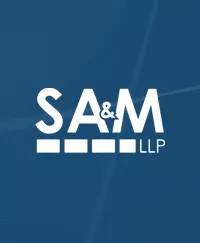This blog article provides a very brief summary of the business tax changes in the new federal tax legislation, the Tax Cuts and Jobs Act of 2017, H.R. 1.
- Tax Rates. There are several important changes to the tax rates on business income. For tax years beginning after December 31, 2017, the C corporation tax rate will be a flat 21%, down from the former maximum rate of 35%.
- Dividend Received Deduction. The dividend received deduction for dividends that C corporations receive from other C corporations will be reduced from 70% to 50% for corporations that are not affiliated. The reduction is intended to be proportionate with the reduction in the corporate tax rate.
- Bonus Depreciation. Bonus depreciation increases to 100% (meaning 100% deduction for the cost of qualified personal property purchases by a business) through 2022 and then phases out by 20% per year from 2023 through 2027.
- Section 179 deduction. Increases to $1,000,000 maximum through 2022. The $1 million deduction amount is reduced by every dollar over $2.5 million that the company has paid for qualified depreciable tangible personal property.
- Special rule for depreciation of automobiles: the maximum amount of allowable depreciation is increased to: $10,000 for the year in which the vehicle is placed in service, $16,000 for the second year, $9,600 for the third year, and $5,760 for the fourth and later years in the recovery period.
- Excess Business Losses: For tax years beginning after Dec. 31, 2017 and before Jan. 1, 2026, the Act provides that a noncorporate taxpayer's “excess business loss” is disallowed. Under the new rule, excess business losses are not allowed for the tax year but are instead carried forward and treated as part of the taxpayer's net operating loss (NOL) carryforward in subsequent tax years. This limitation applies after the application of the passive loss rules described above. (Code Sec. 461(l), as added by Act Sec. 11012)
An excess business loss for the tax year is the excess of aggregate deductions of the taxpayer attributable to the taxpayer's trades and businesses, over the sum of aggregate gross income or gain of the taxpayer plus a threshold amount. The threshold amount for a tax year is $500,000 for married individuals filing jointly, and $250,000 for other individuals, with both amounts indexed for inflation. (Code Sec. 461(l)(3), as added by Act Sec. 11012)
In the case of a partnership or S corporation, the provision applies at the partner or shareholder level. Each partner's or S corporation shareholder's share of items of income, gain, deduction, or loss of the partnership or S corporation is taken into account in applying the above limitation for the tax year of the partner or S corporation shareholder; and regulatory authority is provided to apply the new provision to any other pass-through entity to the extent necessary, as well as to require any additional reporting as IRS determines is appropriate to carry out the purposes of the provision. (Code Sec. 461(l)(4), as added by Act Sec. 11012(a))
- Limitation on use of cash method of accounting. The upper limit on the use of the cash method of accounting is increased from $5 million in average gross receipts over the last 3 years to $25 million.
- AMT Repeal. The corporate alternative minimum tax is repealed effective for tax years beginning after December 31, 2017.
- Depreciable life. The depreciation life for residential real estate is reduced to 30 years for residential real estate placed in service after December 31, 2017. The depreciation life for improvements on rented property is 15 years, straight line.
- Business Interest Expense. A business, regardless of form of organization, may not deduct an amount of interest paid or accrued greater than 30% of the adjusted taxable income of the business.
- No NOL Carrybacks. For NOLs arising in tax years ending after Dec. 31, 2017, the two-year carryback and the special carryback provisions are repealed. For losses arising in tax years beginning after Dec. 31, 2017, the NOL deduction is limited to 80% of taxable income (determined without regard to the deduction). Carryovers to other years are adjusted to take account of this limitation, and, except as provided below, NOLs can be carried forward indefinitely.
- Section 199 Repeal. The qualified domestic production activities deduction under Section 199 is repealed. Section 199 allowed immediate deductibility of wages paid in connection with production performed in the United States. Instead, qualified capital assets may qualify for bonus depreciation equal to 100% of the cost of the film or show.
- Excess executive compensation. For tax years beginning after Dec. 31, 2017, the exceptions to the $1 million deduction limitation for commissions and performance-based compensation are repealed. The definition of “covered employee” is revised to include the principal executive officer, the principal financial officer, and the three other highest paid officers. If an individual is a covered employee with respect to a corporation for a tax year beginning after Dec. 31, 2016, the individual remains a covered employee for all future years. The new rules do not apply to compensation paid pursuant to an employment contract in continuous effect since November 2, 2017.
- Contributions to capital of a corporation. Effective for contributions made after the date of enactment (except as otherwise provided below), the Act provides that the term “contributions to capital” does not include:
(1) any contribution in aid of construction or any other contribution as a customer or potential customer, and
(2) any contribution by any governmental entity or civic group (other than a contribution made by a shareholder as such). (Code Sec. 118, as amended by Act Sec. 13312)
- Like kind exchanges will be limited only to real estate held in the exchanging party’s trade or business.
- Qualified Business Income. A non-corporate taxpayer, including a trust or estate, who has qualified business income (QBI) from a partnership, S corporation, or sole proprietorship will be allowed to deduct:
- (1) the lesserof: (a) the “combined qualified business income amount” of the taxpayer, or (b) 20% of the excess, if any, of the taxable income of the taxpayer for the tax year over the sum of net capital gain and the aggregate amount of the qualified cooperative dividends of the taxpayer for the tax year; plus
- (2) the lesserof: (i) 20% of the aggregate amount of the qualified cooperative dividends of the taxpayer for the tax year, or (ii) taxable income (reduced by the net capital gain) of the taxpayer for the tax year. (Code Sec. 199A(a)
The “combined qualified business income amount” means, for any tax year, an amount equal to: (i) the deductible amount for each qualified trade or business of the taxpayer (defined as 20% of the taxpayer's QBI subject to the W-2 wage limit; see below); plus (ii) 20% of the aggregate amount of qualified real estate investment trust (REIT) dividends and qualified publicly traded partnership income of the taxpayer for the tax year. (Code Sec. 199A(b))
QBI is generally defined as the net amount of “qualified items of income, gain, deduction, and loss” relating to any qualified trade or business of the taxpayer. (Code Sec. 199A(c)(1).) For this purpose, qualified items of income, gain, deduction, and loss are items of income, gain, deduction, and loss to the extent these items are effectively connected with the conduct of a trade or business within the U.S. under Code Sec. 864(c) and included or allowed in determining taxable income for the year. If the net amount of qualified income, gain, deduction, and loss relating to qualified trade or businesses of the taxpayer for any tax year is less than zero, the amount is treated as a loss from a qualified trade or business in the succeeding tax year. (Code Sec. 199A(c)(2)) QBI does not include: certain investment items; reasonable compensation paid to the taxpayer by any qualified trade or business for services rendered with respect to the trade or business; any guaranteed payment to a partner for services to the business under Code Sec. 707(c); or a payment under Code Sec. 707(a) to a partner for services rendered with respect to the trade or business.
The 20% deduction is not allowed in computing adjusted gross income (AGI), but rather is allowed as a deduction reducing taxable income. (Code Sec. 62(a).)
Excluded businesses include: health (i.e., medical services by physicians, nurses, dentists, and other similar healthcare professionals, but not services not directly related to healthcare, such as the operation of spas and health clubs), law, accounting, actuarial science, performing arts (but not services by persons other than performing artists, such as promoters or broadcasters), consulting, athletics, financial services, brokerage services, including investing and investment management, trading, or dealing in securities, partnership interests, or commodities, and any trade or business where the principal asset of such trade or business is the reputation or skill of one or more of its employees”
Limitations. For pass-through entities, other than sole proprietorships, the deduction cannot exceed the greater of:
(1) 50% of the W-2 wages with respect to the qualified trade or business (“W-2 wage limit”), or
(2) the sum of 25% of the W-2 wages paid with respect to the qualified trade or business plus 2.5% of the unadjusted basis, immediately after acquisition, of all “qualified property.” Qualified property is tangible, depreciable property held by and available for use in the qualified trade or business at the close of the tax year, and used at any point during the tax year in the production of qualified business income, and the depreciable period for which has not ended before the close of the tax year.
The second limitation, which was newly added to the bill during Conference, apparently allows pass-through businesses to be eligible for the deduction on the basis of owning property that qualifies under the provision (e.g., real estate).
For a partnership or S corporation, each partner or shareholder is treated as having W-2 wages for the tax year in an amount equal to his or her allocable share of the W-2 wages of the entity for the tax year. A partner's or shareholder's allocable share of W-2 wages is determined in the same way as the partner's or shareholder's allocable share of wage expenses. For an S corporation, an allocable share is the shareholder's pro rata share of an item. However, the W-2 wage limit begins phasing out in the case of a taxpayer with taxable income exceeding $315,000 for married individuals filing jointly ($157,500 for other individuals). The application of the W-2 wage limit is phased in for individuals with taxable income exceeding these thresholds, over the next $100,000 of taxable income for married individuals filing jointly ($50,000 for other individuals). (Code Sec. 199A(b)(3)
Thresholds and exclusions. The deduction does not apply to specified service businesses (i.e., trades or businesses described in Code Sec. 1202(e)(3)(A), but excluding engineering and architecture; and trades or businesses that involve the performance of services that consist of investment-type activities). However the service business limitation begins phasing out in the case of a taxpayer whose taxable income exceeds $315,000 for married individuals filing jointly ($157,500 for other individuals), both indexed for inflation after 2018. The benefit of the deduction for service businesses is phased out over the next $100,000 of taxable income for joint filers ($50,000 for other individuals). (Code Sec. 199A(d).) The deduction also does not apply to the trade or business of being an employee.
- 100% exemption for foreign-source dividends: 100% of the foreign-source portion of dividends received by a US corporation from a foreign corporation other than a Passive Foreign Investment Company (PFIC) that is not also a Controlled Foreign Corporation (CFC) in which the US corporation owns at least a 10% stake paid after 12/31/17 are exempt.
— A holding period of more than one year in the stock of the foreign corporation is required.
— No exemption for any dividend received by a US shareholder from a CFC is allowed if the dividend is deductible by the foreign corporation when computing its taxes.
- Qualified equity grants: Qualified employees may elect to defer the inclusion in income of the amount of income attributable to qualified stock. Qualified stock is stock of a corporation if no stock of the employer corporation is publicly traded and the corporation has a written plan under which not less than 80% of all employees who provide services to the corporation are granted stock options or RSUs. The provision applies to stock attributable to options exercised or RSUs settled after December 31, 2017.
- Sexual Harassment Damages. There will be no deduction of the cost of negotiating, entering into and paying for sexual harassment damages if the settlement is subject to a confidentiality agreement.
- The qualified small business stock exclusion remains unchanged.

For more information about our Tax & Estate Planning Practice contact Michael Shaff at

